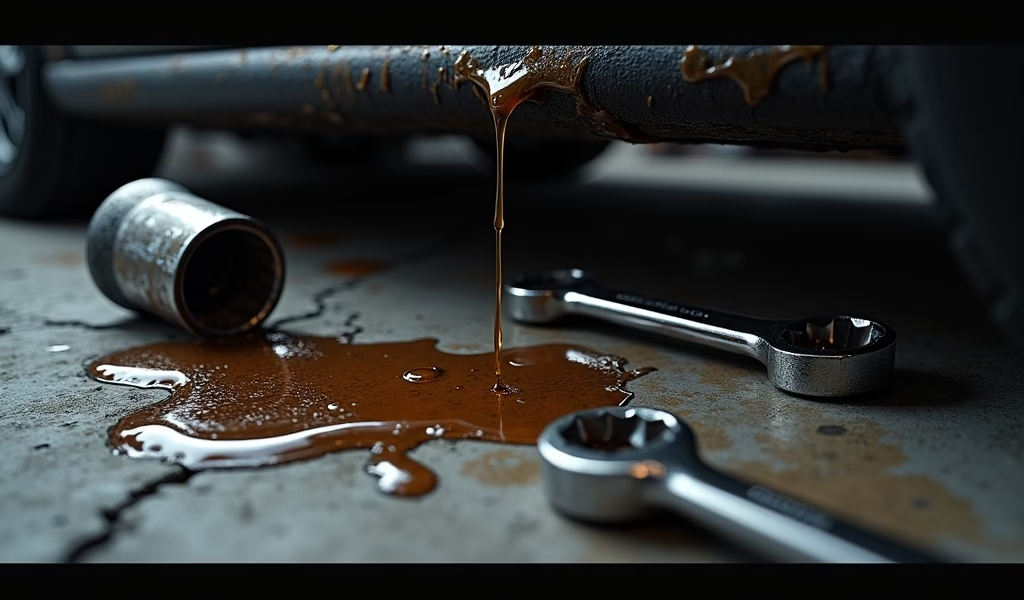Overview
This guide walks beginners through the complete oil change process, from gathering necessary tools to proper disposal, while explaining why regular oil changes extend engine life by up to 50% and improve fuel efficiency by 2-3%. It covers critical information about oil types, common mistakes to avoid, and provides a detailed step-by-step procedure that turns this essential maintenance task into a straightforward DIY project.
The Ultimate Oil Change Guide for Beginners: Keep Your Engine Running Smoothly
Changing your car’s oil might seem intimidating if you’ve never done it before, but it’s actually one of the most straightforward maintenance tasks you can learn. According to a 2023 survey by the Car Care Council, regular oil changes can extend engine life by up to 50% and improve fuel efficiency by an average of 2-3%. As a mechanic with over 15 years of experience, I’ve guided countless first-timers through this essential maintenance task. This comprehensive oil change guide for beginners will walk you through everything you need to know—from gathering supplies to disposing of used oil properly—all in simple, easy-to-follow steps.
Table of Contents
- Why Oil Changes Matter: The Lifeblood of Your Engine
- When to Change Your Oil: Timing is Everything
- Tools and Materials: Getting Prepared
- Step-by-Step Oil Change: The Process Explained
- Choosing the Right Oil: Understanding Your Options
- Common Mistakes: What to Avoid
- Disposal and Cleanup: Being Environmentally Responsible
- Conclusion: You’ve Got This!
- Frequently Asked Questions
Why Oil Changes Matter: The Lifeblood of Your Engine
Think of engine oil as the bloodstream of your car’s heart. It lubricates moving parts, reduces friction, prevents overheating, and carries away harmful contaminants. Over time, oil breaks down and becomes less effective—imagine trying to run with mud in your veins instead of blood. That’s what dirty oil does to your engine.
Fresh oil is amber and translucent. As it ages, it darkens and thickens, becoming less effective at its job. Studies show that 22% of vehicles on the road have dangerously low or degraded oil, which can lead to premature engine failure. Regular oil changes are the single most important preventive maintenance step you can take to extend your vehicle’s life.
Beyond preventing catastrophic engine damage, clean oil improves fuel economy and reduces harmful emissions. Your wallet and the environment both benefit when you stay on top of this simple maintenance task.
When to Change Your Oil: Timing is Everything
The old advice was to change your oil every 3,000 miles, but that’s outdated for most modern vehicles. Today’s engines and synthetic oils have changed the game. Most newer cars can go 7,500 to 10,000 miles between changes, while some can stretch to 15,000 miles with synthetic oil.
How do you know what’s right for your vehicle? First, check your owner’s manual—not what your grandfather or that sticker from the quick-lube place tells you. The manufacturer designed your engine and knows what it needs.

Tools and Materials: Getting Prepared
Before you dive under your car, let’s make sure you have everything you need. Nothing worse than being halfway through an oil change and realizing you’re missing something crucial!
Essential Tools:
- Socket wrench and appropriately sized socket for your drain plug
- Oil filter wrench (size depends on your filter)
- Oil drain pan (4-6 quart capacity)
- Funnel (to prevent messy spills)
- Jack and jack stands OR ramps (if your car sits low)
- Gloves (to keep your hands clean)
- Shop rags or paper towels
Materials You’ll Need:
- The correct amount and type of oil for your vehicle
- New oil filter
- New drain plug washer (if required)
- Container for old oil disposal
Take a minute to double-check your owner’s manual for the specific oil type, viscosity (like 5W-30 or 10W-40), and amount your engine requires. Using the wrong oil can do more harm than good. According to American Petroleum Institute research, using the manufacturer-recommended oil can improve fuel efficiency by up to 2% compared to using an incorrect viscosity.
Step-by-Step Oil Change: The Process Explained
Now for the main event! I’ll walk you through this step by step, just like I’d explain it to a friend in my garage.
Preparation:
- Run your engine for about 5 minutes to warm the oil (warm oil flows better)
- Park on a level surface and engage the parking brake
- If needed, safely raise the front of your car using a jack and secure it with jack stands
The Actual Change:
- Locate the oil drain plug underneath your car (it’s usually a bolt on the bottom of the oil pan)
- Position your drain pan under the plug
- Slowly loosen the drain plug with your socket wrench (be ready for oil flow!)
- Remove the plug completely and let ALL the oil drain (this takes 5-10 minutes)
- While waiting, open your hood and remove the oil filler cap on top of the engine
- Locate the oil filter (cylindrical object, usually accessible from underneath)
- Once the oil is drained, replace and tighten the drain plug
- Remove the old oil filter using an oil filter wrench if necessary
- Take your new filter and apply a thin film of new oil to the rubber gasket
- Install the new filter (follow directions on the filter—usually “tighten by hand”)
- Using a funnel, add new oil through the filler hole (add a bit less than the full amount at first)
- Replace the oil filler cap
Finishing Up:
- Start your engine and let it run for about a minute
- Check for leaks under the car
- Turn off the engine and wait a few minutes for oil to settle
- Check the oil level with the dipstick, adding more if needed
- Reset your oil change reminder if your vehicle has one
This entire process typically takes 30-45 minutes for beginners, but you’ll get faster with practice. Taking your time is important—rushing through a first oil change is how mistakes happen.
As part of your regular car maintenance routine, oil changes become second nature. The sense of accomplishment you’ll feel after completing your first one is genuinely satisfying!
Choosing the Right Oil: Understanding Your Options
Walking down the oil aisle can feel overwhelming with all the different options. Let me simplify this for you.
There are three main types of engine oil:
Conventional Oil:
This is standard, petroleum-based oil. It’s the most affordable option but requires more frequent changes (typically every 3,000-5,000 miles). If your car is older or has higher mileage with no special requirements, conventional oil might be just fine.
Synthetic Oil:
Synthetic oil is chemically engineered to provide superior performance. It flows better in cold temperatures, resists breakdown at high temperatures, and generally lasts longer—often allowing 7,500-15,000 miles between changes. The downside? It costs 2-4 times more than conventional oil.
Synthetic Blend:
As the name suggests, this is a mix of conventional and synthetic oils. It offers some of the benefits of synthetic at a lower price point. Many newer vehicles recommend synthetic blends from the factory.

Common Mistakes: What to Avoid
Even experienced DIYers make mistakes sometimes. Here are the most common ones to watch out for:
Overtightening the Drain Plug or Filter
This is probably the number one mistake I see. The drain plug needs to be snug, not cranked down with all your might. Over-tightening can strip the threads in your oil pan, leading to an expensive repair. For the filter, follow the directions on the package—most recommend “hand-tight plus a quarter turn.”
Using the Wrong Oil
Your car was designed with specific oil requirements in mind. Using the wrong viscosity or type can affect performance and potentially cause damage. Always check your owner’s manual first.
Forgetting to Replace the Oil Filler Cap
This happens more than you’d think! After adding new oil, make sure you securely replace the cap. Driving without it can lead to oil splashing around your engine compartment, creating a mess and potentially causing smoke.
Not Checking for Leaks
After an oil change, always run the engine and check underneath for any signs of leakage. A small drip now can turn into a big problem later. According to the Bureau of Labor Statistics, improper installation during oil changes is one of the leading causes of preventable engine damage.
Remember, it’s normal to make mistakes when you’re learning. If something doesn’t seem right during your oil change, pause and double-check your work or consult a knowledgeable friend before proceeding.
Disposal and Cleanup: Being Environmentally Responsible
Used motor oil is hazardous waste that can contaminate soil and water if improperly disposed of. In fact, the EPA estimates that one gallon of used oil can contaminate one million gallons of fresh water. Being responsible with your used oil isn’t just good citizenship—it’s often required by law.
Proper Disposal Options:
- Most auto parts stores accept used oil for recycling (call ahead to confirm)
- Many municipalities have hazardous waste collection sites
- Some service stations will take used oil
To transport your used oil, pour it from your drain pan into a clean, sealable container (many folks reuse empty oil bottles). Label it clearly as “Used Oil” and keep it upright during transport to avoid spills.
As for cleanup, kitty litter or commercial absorbents work well for soaking up minor spills. For larger spills, check local regulations for proper disposal methods. Never hose oil down a storm drain or sewer—it’s both harmful and illegal.
After completing your DIY auto service, proper cleanup isn’t just about environmental responsibility—it also prevents slips and falls in your garage and keeps your workspace ready for the next project.
Conclusion: You’ve Got This!
Congratulations! You now have all the knowledge needed to perform your first oil change. What seemed intimidating is actually quite straightforward when broken down into manageable steps. Not only will you save money (typically $20-40 per change compared to service centers), but you’ll also gain valuable insight into how your vehicle works.
Regular oil changes are the cornerstone of good vehicle maintenance. By taking this task into your own hands, you’re joining a proud tradition of self-sufficient car owners who understand that a little preventive care goes a long way.
Remember, the first one might take a bit longer as you find your way around, but it gets easier and faster with each change. Before long, you’ll be the one helping your friends learn this essential skill!
So gather your supplies, set aside an hour on the weekend, and give it a try. Your engine (and your wallet) will thank you for it.
Frequently Asked Questions
How often should I really change my oil?
For most modern cars using synthetic oil, every 7,500-10,000 miles is sufficient. Always check your owner’s manual for the manufacturer’s specific recommendation.
Can I mix synthetic and conventional oil?
Yes, they can be mixed in an emergency, but it’s not ideal for regular use. You’ll lose the full benefits of synthetic oil when mixing.
What happens if I go too long between oil changes?
Oil breaks down and becomes less effective at lubricating and cooling, potentially causing increased engine wear. Extreme neglect can lead to engine failure.
Is it normal for oil to look black shortly after a change?
Yes, oil can darken quickly as it collects contaminants, which is actually a sign it’s doing its job. Color alone isn’t the best indicator of when to change oil.
Do I need to change the oil filter every time I change the oil?
Yes, you should replace the filter with each oil change. The filter traps contaminants, and a clogged filter can restrict oil flow to your engine.

